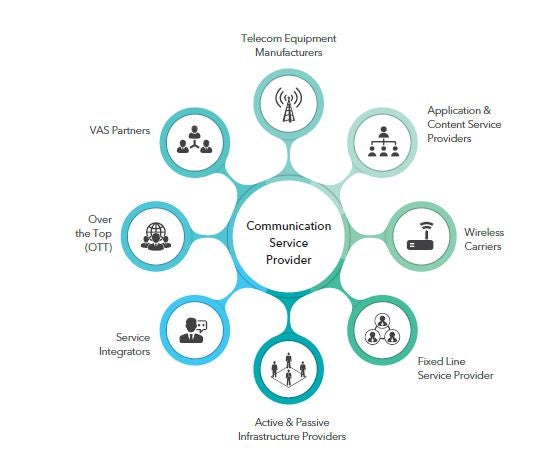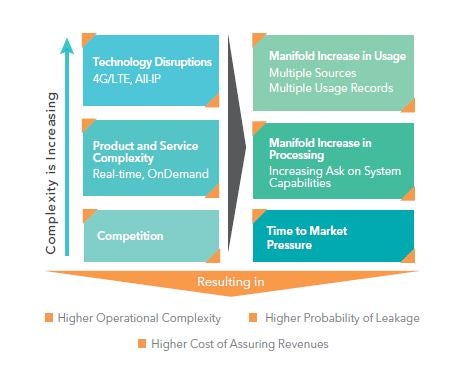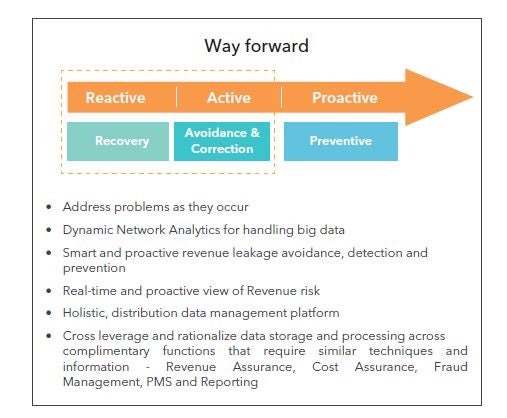
According to the findings of a survey conducted by a leading auditing firm, most operators are losing 0.5% to 10% of the revenue through leakage. Early this year, a global survey of over 90 telecom fraud experts revealed that telecom operators are vulnerable to losing close to USD 300 billion from uncollected revenues and fraud. Out of this estimated loss, about $135 bn is from revenue leakage.
Executives that lead the revenue assurance challenge in their organizations hope to plug a substantial percentage of this leakage, adding heft to bottom lines without investing additional dollars in launching new services or in acquiring new subscribers.
Central to the growing focus on revenue assurance is the fact that while networks, services and partnerships have evolved, the billing and revenue collection functions have failed to keep pace. There is now a pressing need for a remedy.
Revenue leakage occurs for a variety of reasons, chief among which are:
Let’s consider a simple example of a pre-paid subscriber downloading a 2GB movie from a partner content provider. When the subscriber begins the download, the account UDR shows a balance. However, the account balance may be adequate to cover only part of the 2GB download, say up to 1GB. The operator’s system has no insight into this limitation but authorizes the download. Unless the available quota and utilization reconciliation happens in real time, the revenue leak equivalent of 1GB is possible—by which time it is too late. This, and similar revenue leakage scenarios, can be avoided if intelligence is maintained within the operator and partner systems. The intelligence can be used to provide more granular, real-time control over network and service usage. This can be achieved by linking operator and partner systems to customer plans, usage and billing systems in real time.
In the 2G and 3G era, subscriber behavior was different. They were willing to reach out to an operator’s call center, website or make a service request via SMS and wait a few hours for the service to be activated/delivered. This time was used by the operator to ensure systems’ integrity and account balances etc., before turning on the service and billing.
Today, with 4G/ LTE and a culture of instant consumption, even a small delay in service activation can mean loss of revenue. The luxury of time to activate services and plug leakages has gone. With 5G round the corner, revenue assurance is going to become an even greater problem. Already, today’s modern networks are spewing out an inordinate amount of data that is proving difficult to harness and use in real-time. With 5G, the problem will get further accentuated. That is why operators must begin to put in place systems and processes that can manage the complexity of the eco-system along with the growing data volumes (Figure 2: Telecom Providers Under 4G/ LTE Pressure).

The long-term solution for efficient revenue assurance lies in real-time monitoring of quotas and data processing. This is especially applicable for pre-paid subscribers where the risk of revenue loss is greater. To proactively prevent revenue leakage, telecom operators must be able to analyze events and service usage in real-time. This has an implication on the way data is crunched. Operators who opt for real-time monitoring and analysis of usage will need to sift through customer usage patterns, demographic profiles and map them against subscriber package and larger usage trends across the network. (Figure 3: A Proactive Approach to Revenue Assurance) The volume of data this would throw up can be overwhelming, calling for a smart solution for data management and analytics. A smart method of reducing the need for run-time analysis is through personas to guide decisions. Persona-based analytics can substantially reduce the need to examine every data point and thereby still deliver reliable real-time insights.

Telecom operators are improving their ability to forge win-win partnerships with providers in the content, technology and marketing space. They are also trading control over partner systems in exchange for stronger ownership of customers. These strategic positions have a deep impact on revenue assurance. One must bear in mind that the number of subscribers is also growing and their usage will continue to expand as networks become more services-rich. If the velocity and scale of change in billing management systems does not keep pace with the transformation in networks and services, telecom providers will be in serious trouble. To avoid this, existing revenue assurance tools and techniques must be replaced by the next-generation proactive, real-time revenue assurance systems